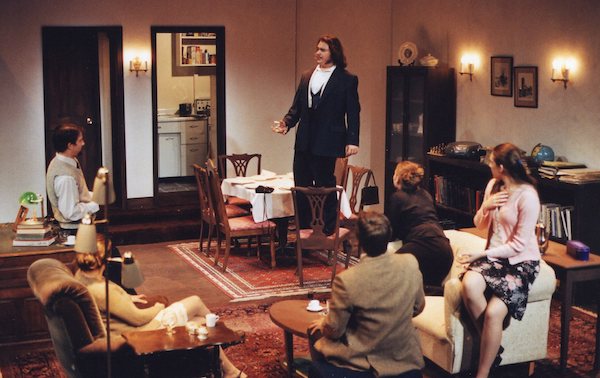
The
University of Minnesota Duluth
Department of Theatre
presents
The Philanthropist
Music Source: Perpetuum Mobile, by The Penguin Cafe
by
Christopher Hampton
Directed by Rachel Katz Carey
Scenic Design by Jeff Johnson
Costume Design by Stacy Mittag
Lighting Design by Mark Harvey
March 13-29, 2003
Dudley Experimental Theatre
Lighting Design Approach
It’s been a while since a play, on first reading, affected
me emotionally as much as Christopher Hampton’s The Philanthropist.
Perhaps it was because Hampton sets his play in two communities I hold dear:
England and higher education. The characters speak in a vernacular I admit I
aspire to, but Hampton reveals a much more bleak image of a culture that assumes
its own intelligence as the highest plane of universal wisdom.
The scenic designer placed the acting space in the corner of the Dudley Experimental
black box with the audience on two adjacent sides of the rectangular set. I
noticed the blocking mirrored the scenery in its angular, even maze-like movements
and wanted the lighting to emphasize this angularity with four distinct functions
of area light set at right angles to one another. The key light for each scene
came from a high back light, indicating time of day. Evening and night scenes
used warm high back light to emphasize the illusion that light was coming from
the many practicals on the stage.

In contrast, day time key light was a high cool white back light.
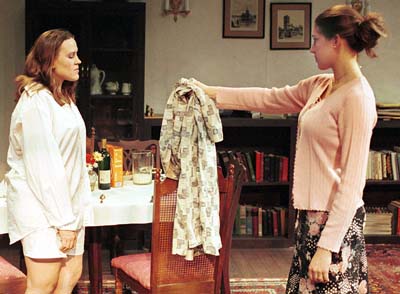
Two sets of fill light were used for visibility for the audience, each at right
angles to the other. Color was a medium cool blue, reinforcing the idea of the
play being set in England in the late fall.
The production called for six scenes and the lighting helped establish time of day for each scene.
Scene 1 - Early evening
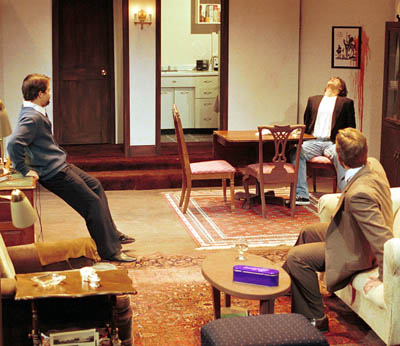
Scene 2 - Early evening (identical to the previous scene)
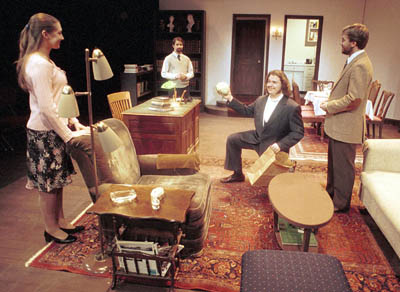
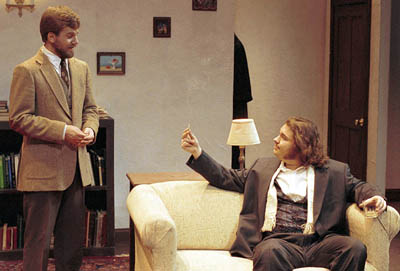
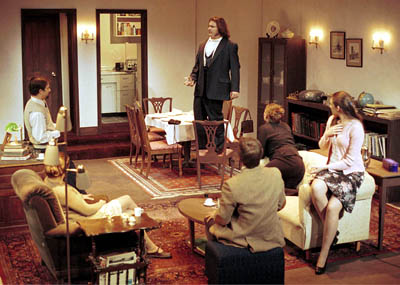
Scene 4 - Morning
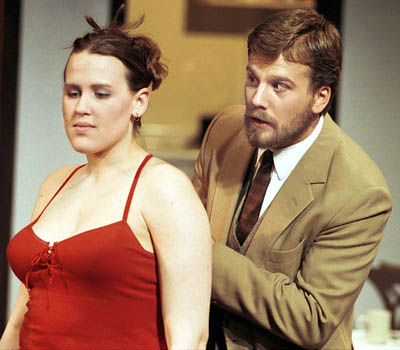
Scene 6 - Early evening (again identical to Scene 1)
To create different looks for each of these scenes, the four lighting functions
were used in contrast to one another. In Scenes 1, 2, and 6, warm high back
light and front fill were balanced with one another. In Scene 3, less front
fill indicated time had moved deeper into the night.
Scene 4 used window patterns of light in warmer tones to indicate a rising sun.
Cool white high back light was balanced with cool front fill to indicate morning.
Scene 5 used the brightest levels of cool white high back light and the least
amount of fill, enhancing the idea of the brightest time of day as well as sculpting
actors’ faces and bodies more profoundly.
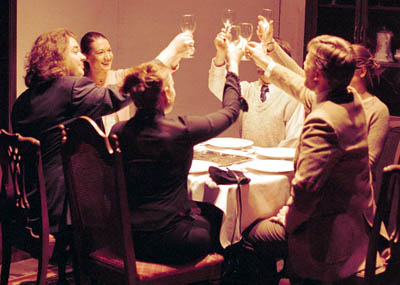
A special was also included to light Philip during the scene shift between Scenes 5 & 6.
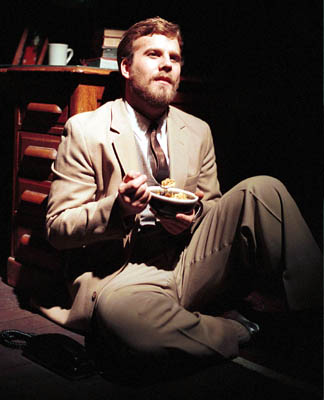
REVIEW
Posted Saturday, March 15, 2003
Actors in The Philanthropist Can Give Only So Much
by PAUL BRISSETT
for THE DULUTH NEWS TRIBUNE
The Philanthropist is either misnamed or titled with sly irony. Christopher
Hampton's play, which opened Thursday at the University of Minnesota Duluth's
Marshall Performing Arts Center, is about a man so terrified of offending people
that he offends by his very lack of self. Hampton's intent was to invert Moliere's
The Misanthrope, an idea he develops with skilled writing, wit and engaging
characters. To these assets the UMD Theatre production adds first-rate staging
and solid acting. But at its core, The Philanthropist is hollow and ultimately
unsatisfying.
The title character is Philip, a scholar of an obscure subspeciality of English
at an unnamed but venerable English university who explains that he can't teach
literature because he has "no critical faculties whatsoever." Matthew
Salmela does an impressive job with a hopelessly paradoxical role. A philanthropist
without a self to give is as much an oxymoron as an impoverished benefactor.
Act I centers on a dinner party during which we see that Philip is surrounded
by people who embody, in varying degrees, Moliere's humanity-hating Alceste.
They include his impatient, passive-aggressive fiancee, Celia, played by Molly
McLain, and the spectacularly boorish blowhard Braham, masterfully rendered
by Ben Elledge. Hampton also introduces some intriguing characters who never
actually appear. They are the students, colleagues and prominent people the
guests take turns sneering at, gossiping about and rendering judgment upon.
In Act II, the focus is narrowed to Philip's relationships with individuals,
chiefly Celia. It is to her that he confesses that, while he likes people well
enough, the driving force in his life is his fear of offending. Philip is more
Pee-Wee Herman than Mother Teresa, which leaves the audience without a central
character to which to react.
Presented with this conundrum, director Rachel Katz Carey has made Philip not
lover, not hater, not fearer. In fact, he's nothing -- alternately an amiable
dishrag and such a naif as to seem dull-witted.
The entire play takes place in Philip's quarters at the university, charmingly
represented by Jeffrey Johnson's set design, which evidences the same attention
to detail as all other aspects of the production: Carey's blocking and stage
business; Stacy Mittag's costumes and Kate Ufema's dialect coaching -- the British
accents sound authentic and, more importantly, are consistent and never impede
intelligibility.
Mark Harvey's lighting design is especially enhancing to several scenes -- and
to the creatively handled scene changes.